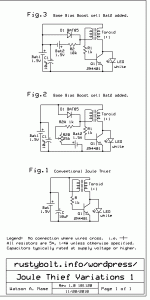In Fig.1, there is a schematic of a conventional Joule Thief. If the battery drops below 0.5V, the circuit will not start on its own because the battery voltage is less than the forward voltage of the base.
In Fig.2, the Bat22 provides about 33 microamps through R21 and R22a and R22b, through the base to forward bias it so the circuit will start up. Once the circuit is running, the feedback winding has high enough voltage to keep the circuit running. The Bat22 will continue to supply about 33 microamps to the circuit as long as it is running. When the main Bat21 is switched off, the Bat22 should also be switched off. But even with the 33 microamps continuous drain on Bat22, it should last for a very long time, several months or a year.
Update – One experimenter posted a video on Youtube of his circuit which used a high ratio between the windings on the toroid. The feedback winding had several times – 5 or more times – the number of turns that the primary winding had. The circuit would start at less than 0.4 volt, which is really low for a conventional JT. It also had no resistor, or zero ohms resistor, which meant that when it had started, a slight increase in battery voltage would dramatically increase the battery current and LED brightness.
Experimenting…
